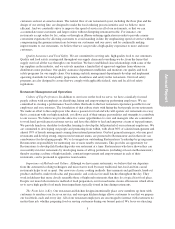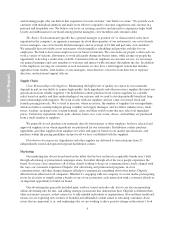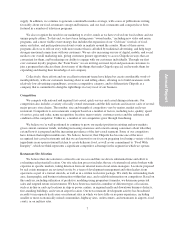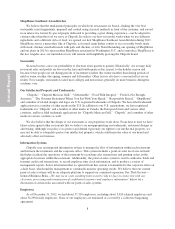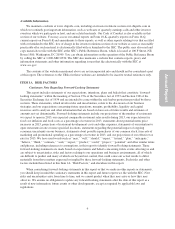Chipotle 2012 Annual Report Download - page 17
Download and view the complete annual report
Please find page 17 of the 2012 Chipotle annual report below. You can navigate through the pages in the report by either clicking on the pages listed below, or by using the keyword search tool below to find specific information within the annual report.
In addition, reports linking nationwide or regional outbreaks of food-borne illnesses have caused us to
temporarily suspend serving some produce items in our foods or to otherwise alter our menu. Similarly, past
outbreaks of E. coli relating to certain food items caused consumers to avoid certain products and restaurant
chains, Asian and European countries have experienced outbreaks of avian flu, and incidents of “mad cow”
disease have occurred in Canadian and U.S. cattle herds. These problems, other food-borne illnesses (such as
hepatitis A or norovirus) and injuries caused by food tampering have had in the past, and could have in the
future, an adverse affect on the price and availability of affected ingredients. If we react to these problems by
changing our menu or other key aspects of the Chipotle experience, we may lose customers who do not accept
those changes, and may not be able to attract enough new customers to generate sufficient revenue to make our
restaurants profitable. Customers may also shift away from us if we choose to pass along to consumers any
higher ingredient costs resulting from supply problems associated with outbreaks of food-borne illnesses, which
would also have a negative impact on our sales and profitability.
Competition could adversely affect us.
The fast-casual, quick-service and casual dining segments of the restaurant industry are highly competitive
with respect to, among other things, taste, price, food quality and presentation, service, location and the ambience
and condition of each restaurant. Our competition includes a variety of restaurants in each of these segments,
including locally owned restaurants and national and regional chains. Many of our competitors offer dine-in,
carry-out and delivery services. Many of our competitors have existed longer than we have and may have a more
established market presence with substantially greater financial, marketing, personnel and other resources than
we have. Among our main competitors are a number of multi-unit, multi-market Mexican food or burrito
restaurant concepts, some of which are expanding nationally. In addition, our strategy includes opening
additional restaurants in existing markets, and as we do so sales may decline in our previously-opened restaurants
as customers who frequent our established restaurants begin to visit a newly-opened restaurant instead.
Several of our competitors compete by offering menu items that are specifically identified as low in
carbohydrates, better for customers or otherwise targeted at particular consumer preferences. Many of our
competitors in the fast-casual and quick-service segments of the restaurant industry also emphasize lower-cost,
“value meal” menu options, a strategy we do not currently pursue. Our sales may be adversely affected by these
products and price competition.
Moreover, we may also compete with companies outside the fast casual and quick service and casual dining
segments of the restaurant industry. For example, competitive pressures can come from deli sections and in-store
cafés of several major grocery store chains, including those targeted at customers who want higher-quality food,
as well as from convenience stores and casual dining outlets. These competitors may have, among other things, a
more diverse menu, lower operating costs, better locations, better facilities, better management, more effective
marketing and more efficient operations than we have.
Any of these competitive factors may adversely affect us and reduce our sales and profits.
Failure to receive frequent deliveries of higher-quality food ingredients and other supplies could harm
our operations.
Our ability to maintain our menu depends in part on our ability to acquire ingredients that meet our
specifications from reliable suppliers. Shortages or interruptions in the supply of ingredients caused by
unanticipated demand, problems in production or distribution, food contamination, inclement weather, a supplier
ceasing operations or other conditions could adversely affect the availability, quality and cost of our ingredients,
which could harm our operations. We have almost no long-term contracts with suppliers, and we have relied
largely on the same third party distribution network as McDonald’s Corporation, from which we separated in
2006. If any of our distributors or suppliers performs inadequately, or our distribution or supply relationships are
disrupted for any reason, our business, financial condition, results of operations or cash flows could be adversely
affected. We currently depend on a limited number of suppliers for some of our key ingredients, including beef,
pork, chicken, beans, rice, sour cream, cheese, and tortillas. Due to the unique nature of the products we receive
15
Annual Report


